Hyperspectral Imaging Combined with Artificial Intelligence in the Early Detection of Esophageal Cancer
Abstract
:Simple Summary
Abstract
1. Introduction
2. Materials and Methods
3. Results
4. Discussion
5. Conclusions
Author Contributions
Funding
Institutional Review Board Statement
Informed Consent Statement
Data Availability Statement
Conflicts of Interest
References
- Holmes, R.S.; Vaughan, T.L. Epidemiology and Pathogenesis of Esophageal Cancer. Semin. Radiat. Oncol. 2007, 17, 2–9. [Google Scholar] [CrossRef]
- Layke, J.C.; Lopez, P.P. Esophageal cancer: A review and update. Am. Fam. Physician 2006, 73, 2187–2194. [Google Scholar]
- Barret, M.; Prat, F. Diagnosis and treatment of superficial esophageal cancer. Ann. Gastroenterol. 2018, 31, 256–265. [Google Scholar] [CrossRef]
- Wu, I.-C.; Syu, H.-Y.; Jen, C.-P.; Lu, M.-Y.; Chen, Y.-T.; Wu, M.-T.; Kuo, C.-T.; Tsai, Y.-Y.; Wang, H.-C. Early identification of esophageal squamous neoplasm by hyperspectral endoscopic imaging. Sci. Rep. 2018, 8, 13797. [Google Scholar] [CrossRef] [PubMed]
- Hsiao, Y.-P.; Chiu, C.-W.; Lu, C.-W.; Nguyen, H.; Tseng, Y.; Hsieh, S.-C.; Wang, H.-C. Identification of Skin Lesions by Using Single-Step Multiframe Detector. J. Clin. Med. 2021, 10, 144. [Google Scholar] [CrossRef] [PubMed]
- Yao, H.-Y.; Tseng, K.-W.; Nguyen, H.-T.; Kuo, C.-T.; Wang, H.-C. Hyperspectral Ophthalmoscope Images for the Diagnosis of Diabetic Retinopathy Stage. J. Clin. Med. 2020, 9, 1613. [Google Scholar] [CrossRef]
- Chang, S.-C.; Syu, H.-Y.; Wang, Y.-L.; Lai, C.-J.; Huang, S.-Y.; Wang, H.-C. Identifying the incidence level of periodontal disease through hyperspectral imaging. Opt. Quantum Electron. 2018, 50, 409. [Google Scholar] [CrossRef]
- Hsiao, Y.-P.; Wang, H.-C.; Chen, S.-H.; Tsai, C.-H.; Yang, J.-H. Identified early stage mycosis fungoides from psoriasis and atopic dermatitis using non-invasive color contrast enhancement by LEDs lighting. Opt. Quantum Electron. 2014, 47, 1599–1611. [Google Scholar] [CrossRef]
- Hsiao, Y.-P.; Wang, H.-C.; Chen, S.-H.; Tsai, C.-H.; Yang, J.-H. Optical perception for detection of cutaneous T-cell lymphoma by multi-spectral imaging. J. Opt. 2014, 16, 125301. [Google Scholar] [CrossRef]
- Jen, C.-P.; Huang, C.-T.; Chen, Y.-S.; Kuo, C.-T.; Wang, H.-C. Diagnosis of human bladder cancer cells at different stages using mul-tispectral imaging microscopy. IEEE J. Sel. Top. Quantum Electron. 2013, 20, 81–88. [Google Scholar] [CrossRef]
- El-Rahman, S.A. Hyperspectral image classification using unsupervised algorithms. IJACSA Int. J. Adv. Comput. Sci. Appl. 2016, 7, 198–205. [Google Scholar]
- Manolakis, D.; Shaw, G. Detection algorithms for hyperspectral imaging applications. IEEE Signal Process. Mag. 2002, 19, 29–43. [Google Scholar] [CrossRef]
- Pohl, C.; Van Genderen, J. Remote Sensing Image Fusion: A Practical Guide; CRC Press: Boca Raton, FL, USA, 2016. [Google Scholar]
- Le Berre, C.; Sandborn, W.J.; Aridhi, S.; Devignes, M.; Fournier, L.; Smail-Tabbone, M.; Danese, S.; Peyrin-Biroulet, L. Application of artificial intelligence to gastroenterology and hepatology. Gastroenterology 2020, 158, 76–94.e2. [Google Scholar] [CrossRef] [Green Version]
- Wang, Y.-K.; Syu, H.-Y.; Chen, Y.-H.; Chung, C.-S.; Tseng, Y.; Ho, S.-Y.; Huang, C.-W.; Wu, I.-C.; Wang, H.-C. Endoscopic Images by a Single-Shot Multibox Detector for the Identification of Early Cancerous Lesions in the Esophagus: A Pilot Study. Cancers 2021, 13, 321. [Google Scholar] [CrossRef]
- Cai, S.-L.; Li, B.; Tan, W.-M.; Niu, X.-J.; Yu, H.-H.; Yao, L.-Q.; Zhou, P.-H.; Yan, B.; Zhong, Y.-S. Using a deep learning system in endoscopy for screening of early esophageal squamous cell carcinoma (with video). Gastrointest. Endosc. 2019, 90, 745–753.e2. [Google Scholar] [CrossRef]
- Ebigbo, A.; Mendel, R.; Probst, A.; Manzeneder, J., Jr.; Papa, J.P.; Palm, C.; Messmann, H. Computer-aided diagnosis using deep learning in the evaluation of early oesophageal adenocarcinoma. Gut 2018, 68, 1143–1145. [Google Scholar] [CrossRef] [Green Version]
- Zhao, Y.-Y.; Xue, D.-X.; Wang, Y.-L.; Zhang, R.; Sun, B.; Cai, Y.; Feng, H.; Cai, Y.; Xu, J. Computer-assisted diagnosis of early esophageal squamous cell carcinoma using nar-row-band imaging magnifying endoscopy. Endoscopy 2019, 51, 333–341. [Google Scholar]
- Guo, L.; Xiao, X.; Wu, C.; Zeng, X.; Zhang, Y.; Du, J.; Bai, S.; Xie, J.; Zhang, Z.; Li, Y.; et al. Real-time automated diagnosis of precancerous lesions and early esophageal squamous cell car-cinoma using a deep learning model (with videos). Gastrointest. Endosc. 2020, 91, 41–51. [Google Scholar] [CrossRef]
- Kumagai, Y.; Takubo, K.; Kawada, K.; Aoyama, K.; Endo, Y.; Ozawa, T.; Hirasawa, T.; Yoshio, T.; Ishihara, S.; Fujishiro, M.; et al. Diagnosis using deep-learning artificial intelligence based on the endocytoscopic observation of the esophagus. Esophagus 2018, 16, 180–187. [Google Scholar] [CrossRef]
- Horie, Y.; Yoshio, T.; Aoyama, K.; Yoshimizu, S.; Horiuchi, Y.; Ishiyama, A.; Hirasawa, T.; Tsuchida, T.; Ozawa, T.; Ishihara, S.; et al. Diagnostic outcomes of esophageal cancer by artificial intelligence using convolutional neural networks. Gastrointest. Endosc. 2018, 89, 25–32. [Google Scholar] [CrossRef]
- Shahidi, N.; Bourke, M.J. Can artificial intelligence accurately diagnose endoscopically curable gastrointestinal cancers? Tech. Innov. Gastrointest. Endosc. 2020, 22, 61–65. [Google Scholar] [CrossRef]
- Tokai, Y.; Yoshio, T.; Aoyama, K.; Horie, Y.; Yoshimizu, S.; Horiuchi, Y.; Ishiyama, A.; Tsuchida, T.; Hirasawa, T.; Sakakibara, Y.; et al. Application of artificial intelligence using convolutional neural networks in determining the invasion depth of esophageal squamous cell carcinoma. Esophagus 2020, 17, 250–256. [Google Scholar] [CrossRef]
- Fukuda, H.; Ishihara, R.; Kato, Y.; Matsunaga, T.; Nishida, T.; Yamada, T.; Ogiyama, H.; Horie, M.; Kinoshita, K.; Tada, T. Comparison of performances of artificial intelligence versus expert endoscopists for re-al-time assisted diagnosis of esophageal squamous cell carcinoma (with video). Gastrointest. Endosc. 2020, 92, 848–855. [Google Scholar] [CrossRef]
- Liu, W.; Anguelov, D.; Erhan, D.; Szegedy, C.; Reed, S.; Fu, C.Y.; Berg, A.C. Ssd: Single Shot Multibox Detector; Springer: Cham, Switzerland, 2016; pp. 21–37. [Google Scholar]
- Simonyan, K.; Zisserman, A. Very deep convolutional networks for large-scale image recognition. arXiv 2014, arXiv:14091556. [Google Scholar]
- Szegedy, C.; Reed, S.; Erhan, D.; Anguelov, D.; Ioffe, S. Scalable, high-quality object detection. arXiv 2014, arXiv:14121441. [Google Scholar]
- Uijlings, J.R.; Van De Sande, K.E.; Gevers, T.; Smeulders, A.W. Selective search for object recognition. Int. J. Comput. Vision. 2013, 104, 154–171. [Google Scholar] [CrossRef] [Green Version]
- Saito, S.; Lin, Y.-C.; Nakamura, Y.; Eckner, R.; Wuputra, K.; Kuo, K.-K.; Lin, C.-S.; Yokoyama, K.K. Potential application of cell reprogramming techniques for cancer research. Cell. Mol. Life Sci. 2018, 76, 45–65. [Google Scholar] [CrossRef] [Green Version]
- Rodarmel, C.; Shan, J. Principal component analysis for hyperspectral image classification. Surv. Land Inf. Science. 2002, 62, 115–122. [Google Scholar]
- McHugh, M.L. Interrater reliability: The kappa statistic. Biochem. Med. 2012, 276–282. [Google Scholar] [CrossRef]
- Landis, J.R.; Koch, G.G. An application of hierarchical kappa-type statistics in the assessment of majority agreement among multiple observers. Biometrics 1977, 33, 363–374. [Google Scholar] [CrossRef]
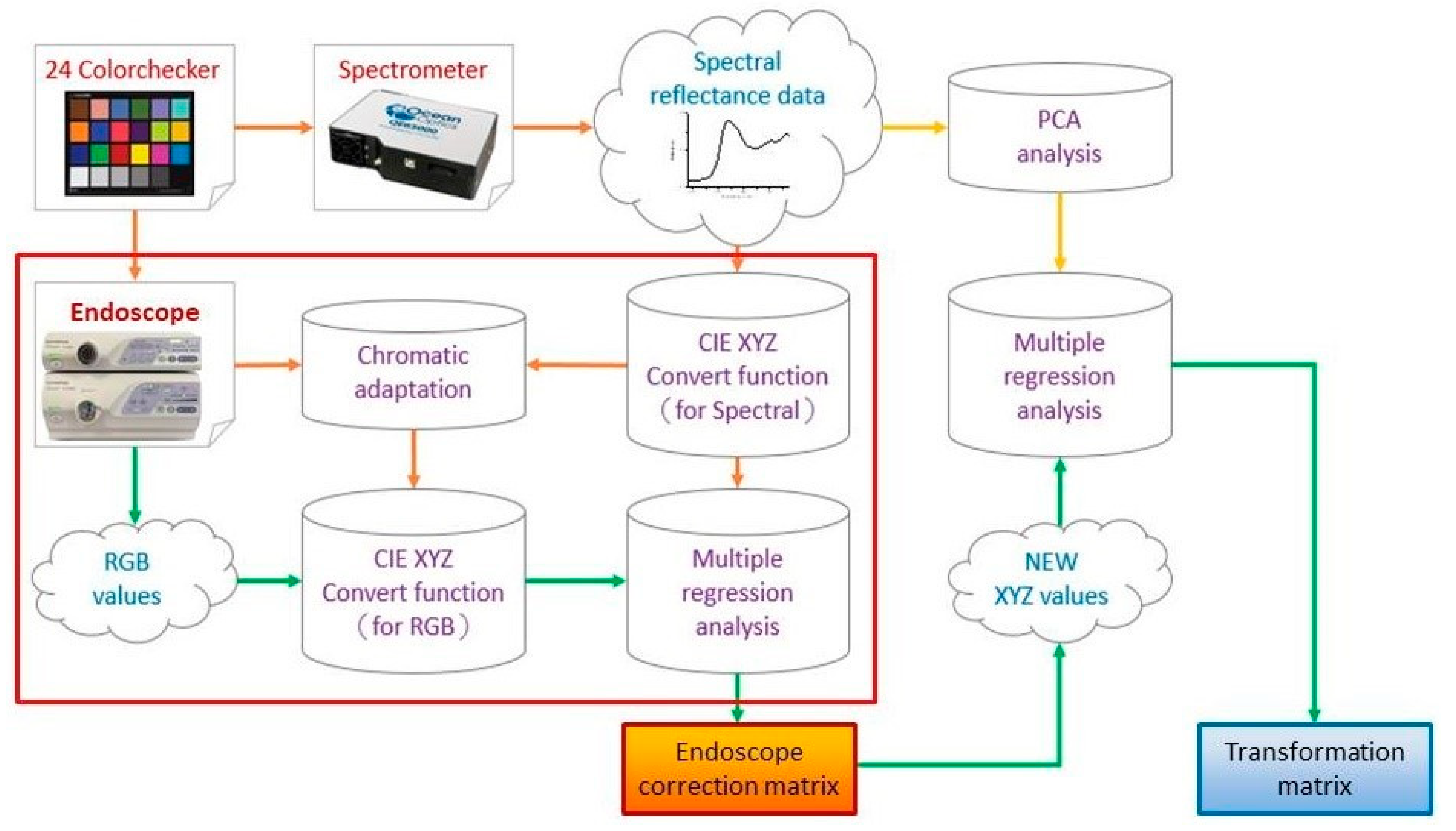
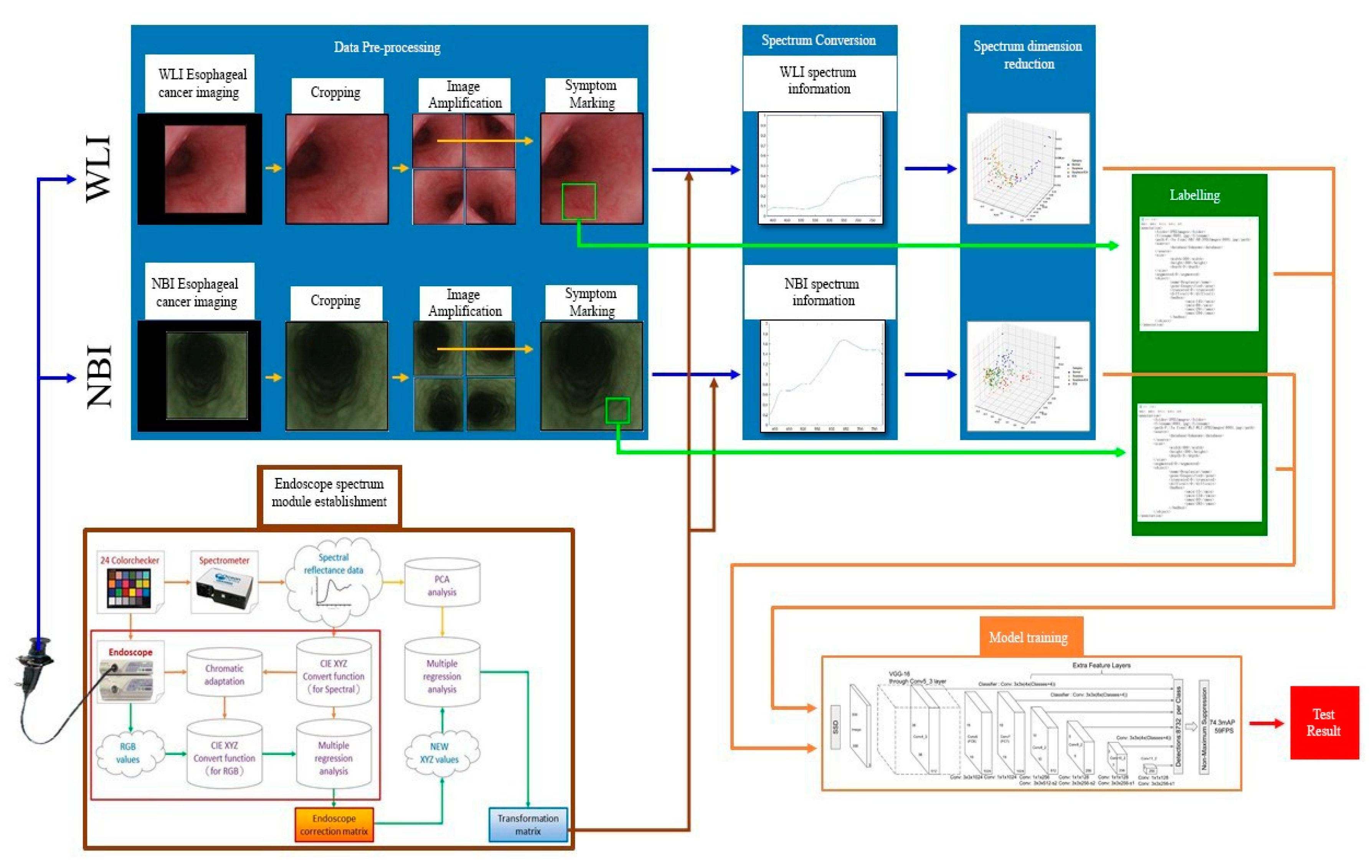
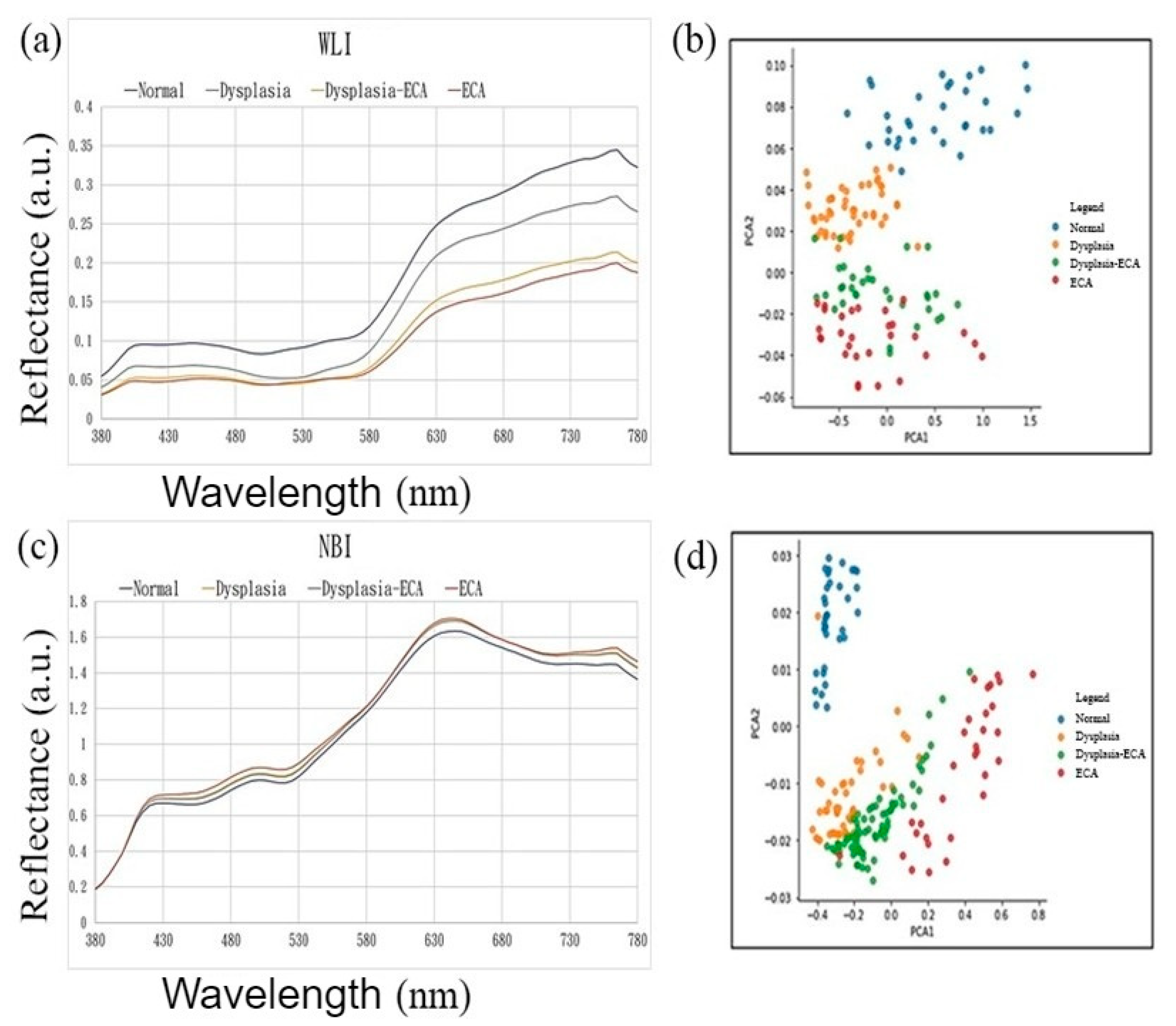
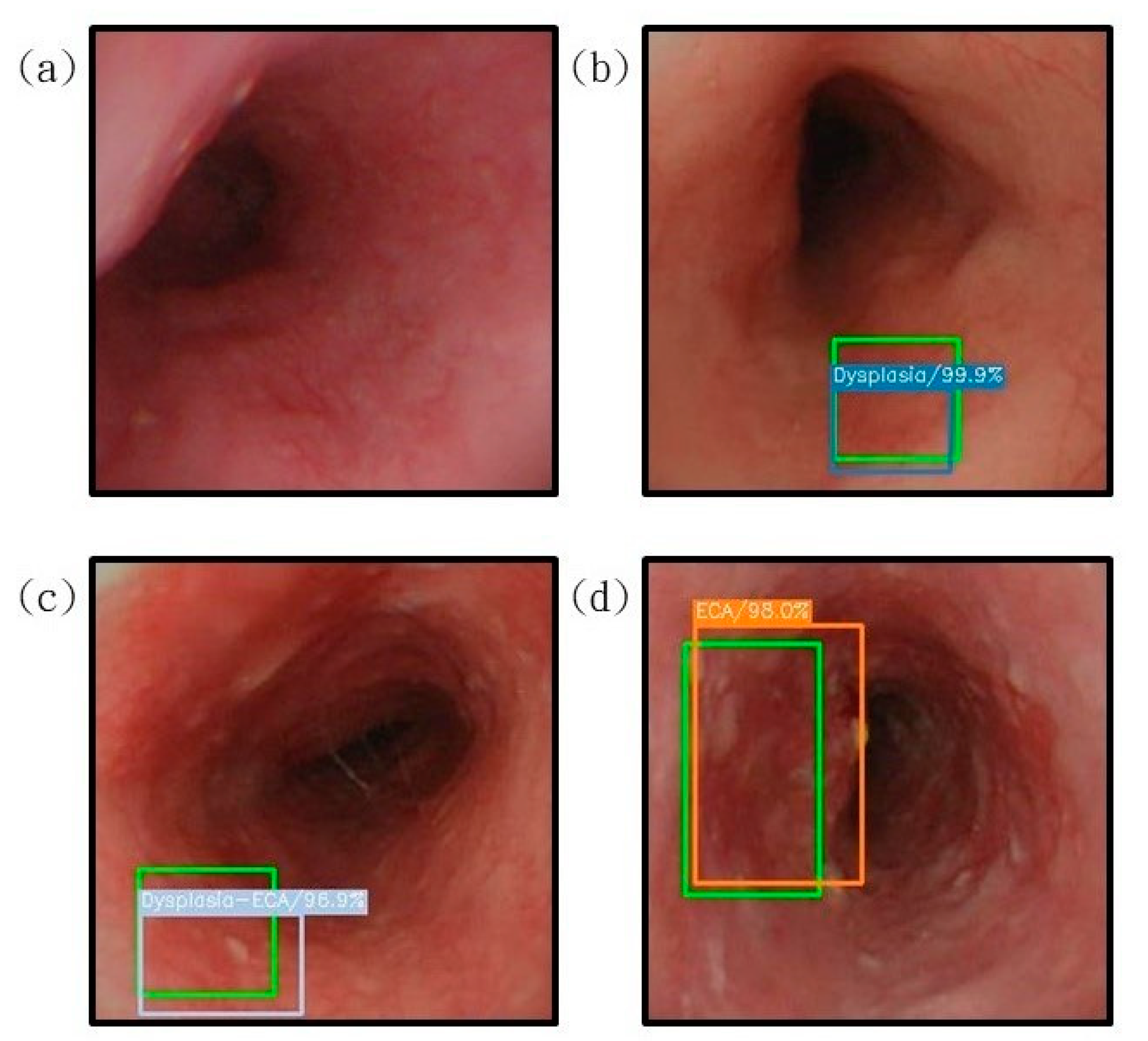
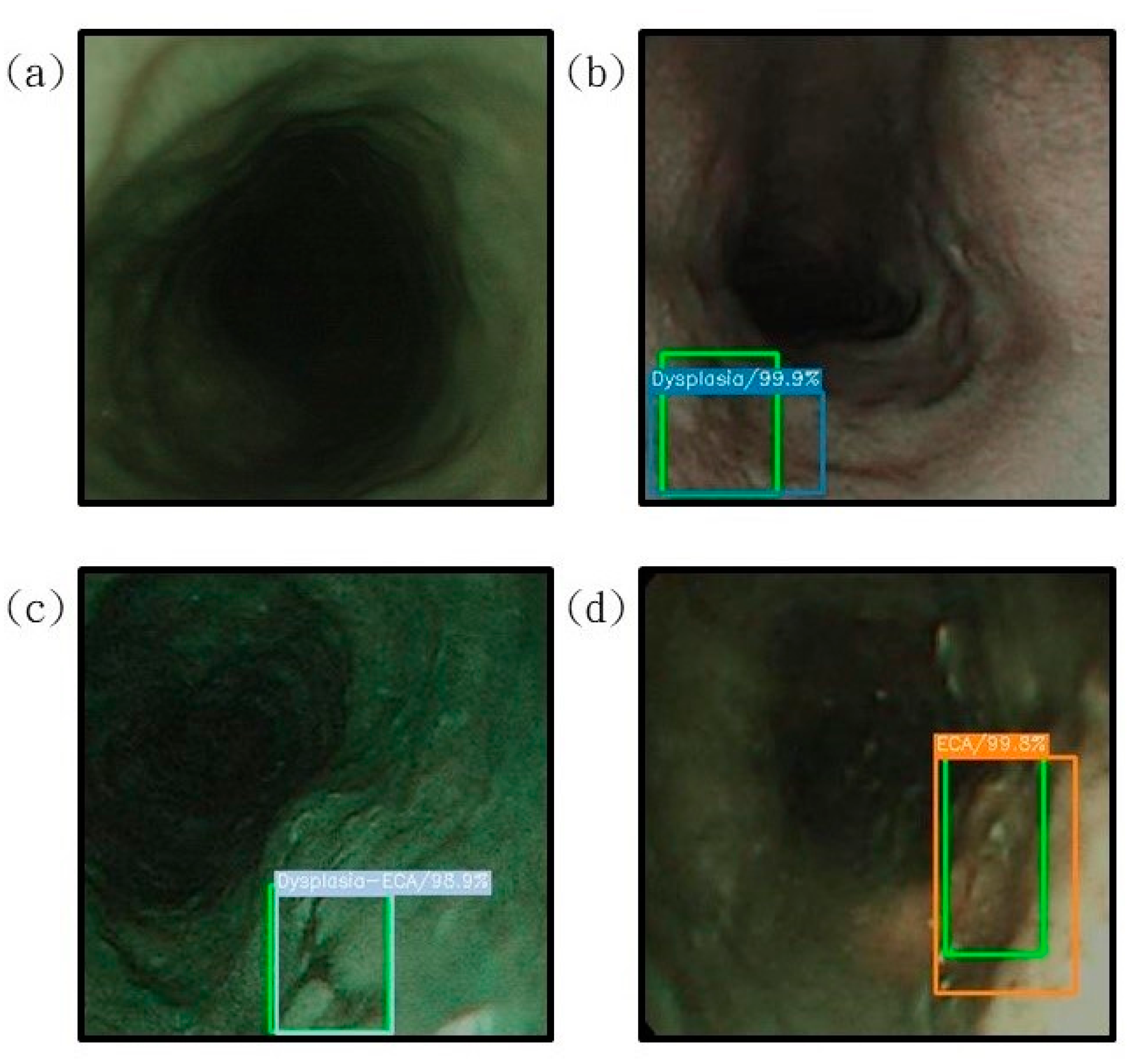
| WLI RGB | Sensitivity (%) | Precision (%) | F1-Score (%) | Accuracy (%) | Kappa |
| Normal | 76 | 72 | 74 | 83 | 0.76 |
| Low-grade dysplasia | 61 | 85 | 71 | ||
| High-grade dysplasia | 86 | 86 | 86 | ||
| Invasive cancer | 93 | 85 | 89 | ||
| NBI RGB | Sensitivity (%) | Precision (%) | F1-score (%) | Accuracy (%) | Kappa |
| Normal | 68 | 89 | 77 | 86 | 0.81 |
| Low-grade dysplasia | 83 | 88 | 85 | ||
| High-grade dysplasia | 88 | 86 | 87 | ||
| Invasive cancer | 98 | 84 | 90 | ||
| WLI spectrum | Sensitivity (%) | Precision (%) | F1-score (%) | Accuracy (%) | Kappa |
| Normal | 92 | 85 | 88 | 88 | 0.84 |
| Low-grade dysplasia | 75 | 84 | 79 | ||
| High-grade dysplasia | 92 | 88 | 90 | ||
| Invasive cancer | 91 | 92 | 91 | ||
| NBI spectrum | Sensitivity (%) | Precision (%) | F1-score (%) | Accuracy | (%) Kappa |
| Normal | 96 | 89 | 92 | 91 | 0.84 |
| Low-grade dysplasia | 89 | 92 | 91 | ||
| High-grade dysplasia | 91 | 89 | 90 | ||
| Invasive cancer | 91 | 94 | 93 |
| Confusion Matrix | True Value | Total | ||||
|---|---|---|---|---|---|---|
| WLI RGB | Normal | Dysplasia | High-Grade Dysplasia | Invasive Cancer | ||
| Predicted value | Normal | 13 | 3 | 0 | 2 | 112 |
| Low-grade dysplasia | 1 | 11 | 1 | 0 | ||
| High-grade dysplasia | 3 | 1 | 30 | 1 | ||
| Invasive cancer | 0 | 3 | 4 | 39 | ||
| NBI RGB | Normal | Low-Grade Dysplasia | High-grade dysplasia | Invasive Cancer | ||
| Predicted value | Normal | 25 | 2 | 0 | 1 | 152 |
| Low-grade dysplasia | 1 | 15 | 1 | 0 | ||
| High-grade dysplasia | 5 | 1 | 38 | 0 | ||
| Invasive cancer | 6 | 0 | 4 | 53 | ||
| WLI spectrum | Normal | Low-Grade Dysplasia | High-grade dysplasia | Invasive Cancer | ||
| Predicted value | Normal | 23 | 2 | 1 | 1 | 155 |
| Low-grade dysplasia | 2 | 21 | 1 | 1 | ||
| High-grade dysplasia | 0 | 3 | 45 | 3 | ||
| Invasive cancer | 0 | 2 | 2 | 48 | ||
| NBI spectrum | Normal | Low-Grade Dysplasia | High-grade dysplasia | Invasive Cancer | ||
| Predicted value | Normal | 24 | 2 | 1 | 0 | 153 |
| Low-grade dysplasia | 1 | 24 | 0 | 1 | ||
| High-grade dysplasia | 0 | 1 | 41 | 1 | ||
| Invasive cancer | 0 | 0 | 3 | 51 | ||
Publisher’s Note: MDPI stays neutral with regard to jurisdictional claims in published maps and institutional affiliations. |
© 2021 by the authors. Licensee MDPI, Basel, Switzerland. This article is an open access article distributed under the terms and conditions of the Creative Commons Attribution (CC BY) license (https://creativecommons.org/licenses/by/4.0/).
Share and Cite
Tsai, C.-L.; Mukundan, A.; Chung, C.-S.; Chen, Y.-H.; Wang, Y.-K.; Chen, T.-H.; Tseng, Y.-S.; Huang, C.-W.; Wu, I.-C.; Wang, H.-C. Hyperspectral Imaging Combined with Artificial Intelligence in the Early Detection of Esophageal Cancer. Cancers 2021, 13, 4593. https://doi.org/10.3390/cancers13184593
Tsai C-L, Mukundan A, Chung C-S, Chen Y-H, Wang Y-K, Chen T-H, Tseng Y-S, Huang C-W, Wu I-C, Wang H-C. Hyperspectral Imaging Combined with Artificial Intelligence in the Early Detection of Esophageal Cancer. Cancers. 2021; 13(18):4593. https://doi.org/10.3390/cancers13184593
Chicago/Turabian StyleTsai, Cho-Lun, Arvind Mukundan, Chen-Shuan Chung, Yi-Hsun Chen, Yao-Kuang Wang, Tsung-Hsien Chen, Yu-Sheng Tseng, Chien-Wei Huang, I-Chen Wu, and Hsiang-Chen Wang. 2021. "Hyperspectral Imaging Combined with Artificial Intelligence in the Early Detection of Esophageal Cancer" Cancers 13, no. 18: 4593. https://doi.org/10.3390/cancers13184593
APA StyleTsai, C.-L., Mukundan, A., Chung, C.-S., Chen, Y.-H., Wang, Y.-K., Chen, T.-H., Tseng, Y.-S., Huang, C.-W., Wu, I.-C., & Wang, H.-C. (2021). Hyperspectral Imaging Combined with Artificial Intelligence in the Early Detection of Esophageal Cancer. Cancers, 13(18), 4593. https://doi.org/10.3390/cancers13184593









